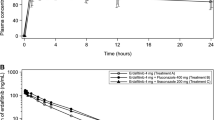Abstract
Sorafenib is a novel, small-molecule anticancer compound that inhibits tumor cell proliferation by targeting Raf in the Raf/MEK/ERK signalling pathway, and inhibits angiogenesis by targeting tyrosine kinases such as vascular-endothelial growth factor receptor (VEGFR-2 and VEGFR-3) and platelet-derived growth factor receptor (PDGFR). In vitro microsomal data indicate that sorafenib is metabolized by two pathways: phase I oxidation mediated by cytochrome P450 (CYP) 3A4; and phase II conjugation mediated by UGT1A9. Approximately 50% of an orally administered dose is recovered as unchanged drug in the feces, due to either biliary excretion or lack of absorption. The aim of this study was to evaluate the effect of CYP3A inhibition by ketoconazole on sorafenib pharmacokinetics. This was an open-label, non-randomized, 2-period, one-way crossover study in sixteen healthy male subjects. A single 50 mg dose of sorafenib was administered alone (period 1) and in combination with ketoconazole 400 mg once daily (period 2) (ketoconazole was given for 7 days, and a single 50 mg sorafenib dose was administered concomitantly on day 4). No clinically relevant change in pharmacokinetics of sorafenib and no clinically relevant adverse events or laboratory abnormalities were observed in this study upon co-administration of the two drugs. Plasma concentrations of the main CYP3A4 generated metabolite, sorafenib N-oxide, decreased considerably upon ketoconazole co-administration. This effect is in accordance with the in vitro finding that CYP3A4 is the primary enzyme for sorafenib N-oxide formation. Further, these data indicate that blocking sorafenib metabolism by the CYP3A4 pathway will not lead to an increase in sorafenib exposure. This is consistent with data from a clinical mass-balance study that showed 15% of the administered dose was eliminated by glucuronidation, compared to less than 5% eliminated as oxidative metabolites. Since there was no increase in sorafenib exposure following concomitant administration of the highly potent CYP3A4 inhibitor ketoconazole with low dose sorafenib, it is postulated that higher therapeutic doses of sorafenib may be safely co-administered with ketoconazole, as well as with other inhibitors of CYP3A.



Similar content being viewed by others
References
Bjornsson TD, Callaghan JT, Einolf HJ, Fischer V, Gan L, Grimm S et al (2003) The conduct of in vitro and in vivo drug-drug interaction studies: a Pharmaceutical Research and Manufacturers of America (PhRMA) perspective. Drug Metab Dispos 31:815–32
Boxenbaum H (1999) Cytochrome P450 3A4 in vivo ketoconazole competitive inhibition: determination of K i and dangers associated with high clearance drugs in general. J Pharm Pharm Sci 2:47–52
DeGrendele H (2003) Activity of the Raf kinase inhibitor BAY 43–9006 in patients with advanced solid tumors. Clin Colorectal Cancer 3:16–18
Food and Drug Administration (FDA) (1999) Guidance for Industry entitled, “In vivo Drug metabolism/Drug interaction studies—study design, data analysis, and recommendations for dosing and labeling, US Department of Health and Human Services, Food and Drug Administration, Rockville, MD. Website: http://www.fda.gov/cber/gdlns/metabol.pdf
Gibbs MA, Thummel KE, Shen DD, Kunze KL (1999) Inhibition of cytochrome P-450 3A (CYP3A) in human intestinal and liver microsomes: comparison of Ki values and impact of CYP3A5 expression. Drug Metab Dispos 27:180–187
Heim M, Sharifi M, Hilger RA, Scheulen ME, Seeber S, Strumberg D (2003) Antitumor effect and potentiation or reduction in cytotoxic drug activity in human colon carcinoma cells by the Raf kinase inhibitor (RKI) BAY 43-9006. Int J Clin Pharmacol Ther 41:616–617
Hotte SJ, Hirte HW (2002) BAY 43-9006: early clinical data in patients with advanced solid malignancies. Curr Pharm Des 8:2249–2253
Ingelman-Sundberg M, Oscarson M, McLellan RA (1999) Polymorphic human cytochrome P450 enzymes: an opportunity for individualized drug treatment. Trends Pharmacol Sci 20:342–349
Lyons JF, Wilhelm S, Hibner B, Bollag G (2001) Discovery of a novel Raf kinase inhibitor. Endocr Relat Cancer 8:219–225
Olkkola KT, Backman JT, Neuvonen PJ (1994) Midazolam should be avoided in patients receiving the systemic antimycotics ketoconazole or itraconazole. Clin Pharmacol Ther 55:481–485
Richly H, Kupsch P, Passage K, Grubert M, Hilger RA, Kredtke S et al (2003) A phase I clinical and pharmacokinetic study of the Raf kinase inhibitor (RKI) BAY 43-9006 administered in combination with doxorubicin in patients with solid tumors. Int J Clin Pharmacol Ther 41:620–621
Rodrigues AD, Winchell GA, Dobrinska MR (2001) Use of in vitro drug metabolism data to evaluate metabolic drug-drug interactions in man: the need for quantitative databases. J Clin Pharmacol 41:368–373
Strumberg D, Voliotis D, Moeller JG, Hilger RA, Richly H, Kredtke S et al (2002) Results of phase I pharmacokinetic and pharmacodynamic studies of the Raf kinase inhibitor BAY 43-9006 in patients with solid tumors. Int J Clin Pharmacol Ther 40:580–581
Strumberg D, Richly H, Hilger RA, Scheuler N, Korfee S, Tewes M et al (2005) Phase I clinical and pharmacokinetic study of the novel Raf kinase and vascular endothelial growth factor receptor inhibitor BAY 43-9006 in patients with advanced refractory solid tumors. J Clin Oncol 23:965–972
Venkatakrishnan K, von Moltke LL, Greenblatt DJ (2000) Effects of the antifungal agents on oxidative drug metabolism: clinical relevance. Clin Pharmacokinet 38:111–180
Zhang W, Ramamoorthy Y, Kilicarslan T, Nolte H, Tyndale RF, Sellers EM (2002) Inhibition of cytochromes P450 by antifungal imidazole derivatives. Drug Metab Dispos 30:314–318
Author information
Authors and Affiliations
Corresponding author
Rights and permissions
About this article
Cite this article
Lathia, C., Lettieri, J., Cihon, F. et al. Lack of effect of ketoconazole-mediated CYP3A inhibition on sorafenib clinical pharmacokinetics. Cancer Chemother Pharmacol 57, 685–692 (2006). https://doi.org/10.1007/s00280-005-0068-6
Received:
Accepted:
Published:
Issue Date:
DOI: https://doi.org/10.1007/s00280-005-0068-6




